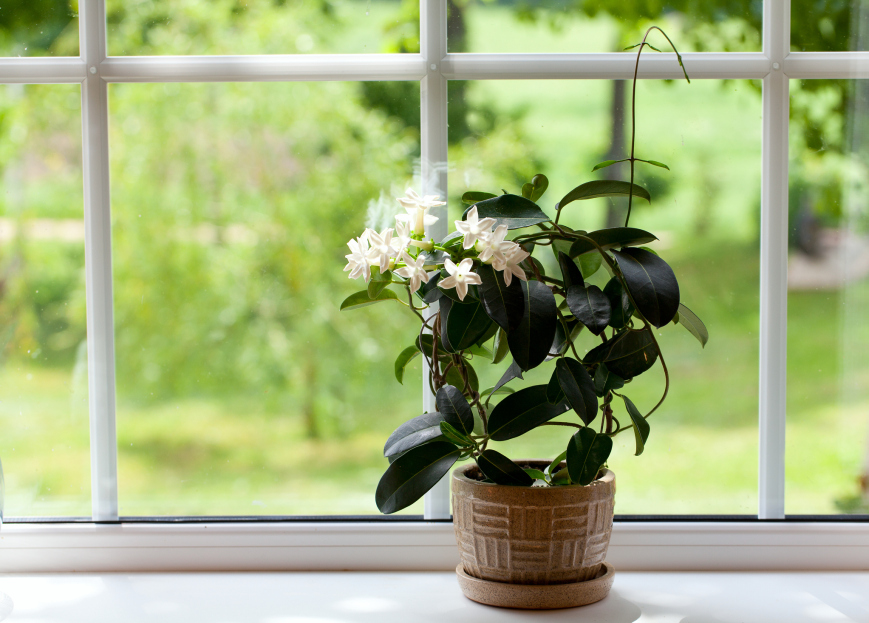
Jasmine (Jasminum spp.) is a beloved flowering plant known for its sweet fragrance and delicate, star-shaped blooms. Whether grown indoors or outdoors, jasmine can add a touch of elegance to your home. As a houseplant, jasmine thrives with the right care, offering a pleasant aroma and beautiful flowers in return. If you’re looking to add this fragrant beauty to your indoor garden, here’s everything you need to know about caring for jasmine.
Jasmine plants thrive in bright, indirect light. Place your jasmine in a location that receives several hours of natural light each day, such as near a south or west-facing window. However, avoid placing it in direct sunlight for extended periods, as this can scorch the delicate leaves and flowers. If you don’t have a sunny spot, jasmine can still grow well under artificial grow lights. Proper lighting is essential for encouraging healthy growth and abundant blooms.
Jasmine prefers moderate watering and should be watered only when the top inch of soil feels dry to the touch. Water thoroughly, ensuring that excess water drains out of the pot. Be careful not to overwater, as jasmine plants are susceptible to root rot. During the growing season (spring and summer), jasmine may need more frequent watering, but in the winter, you can reduce watering as the plant goes into a semi-dormant phase. Always check the moisture level of the soil before watering to avoid waterlogging.
Jasmine plants thrive in moderate to high humidity. In dry indoor environments, especially during the winter months when indoor air tends to be drier, it’s beneficial to increase humidity around your jasmine. You can achieve this by misting the leaves occasionally, placing the pot on a humidity tray filled with water and pebbles, or grouping it with other plants to create a more humid microenvironment. If you have a humidifier, placing it near the plant can also help maintain the humidity levels jasmine needs.
Jasmine prefers well-draining, slightly acidic to neutral soil. A high-quality potting mix that’s light and airy works best, allowing the roots to breathe while preventing water from accumulating at the bottom of the pot. You can mix some perlite or sand into the potting soil to improve drainage. Jasmine plants do not like to sit in soggy soil, so ensure the pot has drainage holes to allow excess water to escape. Regularly check the soil for compacting, as jasmine prefers soil that retains some moisture but drains well.
Jasmine thrives in moderate temperatures, typically between 60-75°F (15-24°C). They can tolerate slightly cooler temperatures but should not be exposed to cold drafts or temperatures below 50°F (10°C), as this can stunt growth and damage the plant. Avoid placing jasmine near heaters, air conditioners, or windows that might cause temperature fluctuations. Maintaining a consistent, warm environment will encourage healthy growth and vibrant blooms.
During the growing season (spring and summer), jasmine benefits from regular feeding to support its flowering. Use a balanced, water-soluble fertilizer diluted to half strength and apply once every 4-6 weeks. Fertilizing too frequently can lead to excessive leaf growth at the expense of blooms, so it’s best to follow a moderate feeding schedule. In the fall and winter, when the plant is not actively growing, reduce or stop fertilizing altogether.
Pruning jasmine is important to maintain its shape and encourage new growth. After the flowering period, trim back any dead or faded flowers to encourage the plant to focus on new blooms. You can also cut back leggy growth to promote a bushier, more compact plant. If your jasmine is a vine variety, regular pruning will help control its size and shape, preventing it from becoming too unruly. Always use clean, sharp pruning shears or a razor blade to avoid damaging the plant.
Jasmine plants generally need to be repotted every 1-2 years to refresh the soil and allow for healthy root growth. When repotting, choose a pot that is 1-2 inches larger in diameter than the current one. Be sure to check the roots for any signs of rot or overcrowding before placing the plant in fresh soil. Repotting is best done in the spring before the plant begins its active growing season.
Jasmine is generally non-toxic to pets. While it is safe for cats, dogs, and other pets to be around, it's still a good idea to keep the plant out of reach of curious animals to prevent them from chewing on the leaves or flowers. If your pet does ingest any part of the plant, it’s unlikely to cause serious harm, but it’s always best to monitor for any signs of gastrointestinal upset and contact your vet if you have concerns.